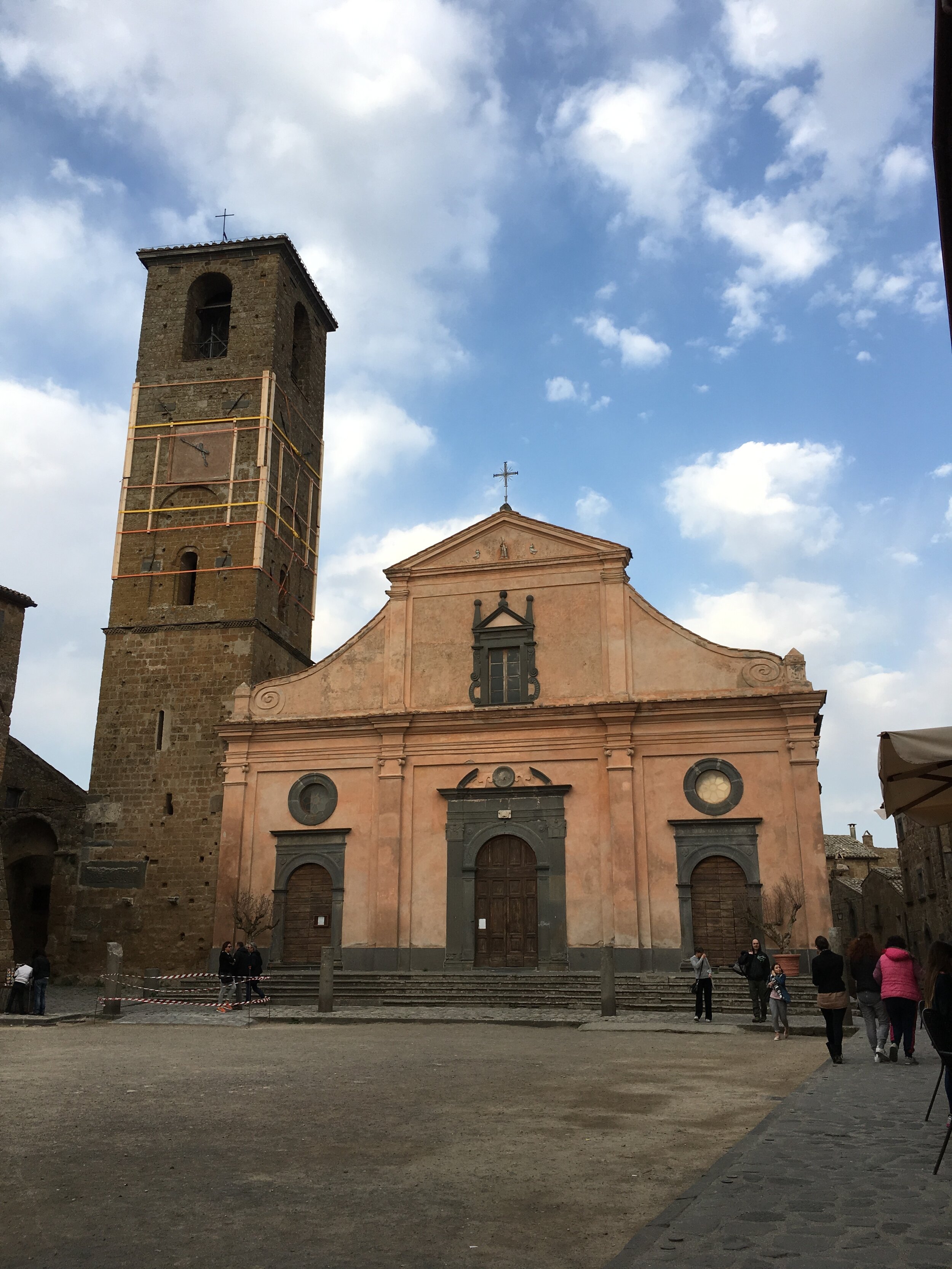Regional Feature- Civita di Bagnoregio
Civita di Bagnoregio has the epithet of La città che muore (the dying town), which provides an interesting linguistic and philosophical contrast with Rome as la citta eterna (the eternal city). Civita di Bagnoregio is now quite ‘alive’ with tourism; thus, an apt question is, is Civita di Bagnoregio ‘to be or not to be’ now and in the future? There is a geological explanation for this foreboding sobriquet, related to the “friable volcanic tuff” it is built upon. According to the Traveling in Tuscany website, the old town is “located in a vast canyon atop a pinnacle ruled by wind and erosion. Perched on top of a hill among the valleys formed by Chiaro and Torbido streams, Civita appears clinged [SIC] to the edge of a cliff where it dominates the wide desolated valley made up of calanchi (badlands is the closest English translation). This isolation is the result of a continuous erosion that makes the tufa rock becoming thinner and thinner, the rock upon which Civita di Bagnoregio was built rests on layers of clay which over time tend to slip downwards, thus determining the collapse of sections of the rock above them.”
I absolutely recommend a day trip to experience for yourself. By car you can arrive from Rome in about 1 hour and 45 minutes. For public transportation, I would take the train to either Orvieto or Viterbo. From either of these towns you can catch a Cotral bus to the Civita di Bagnoregio. As many people lament on Trip Advisor forums, bus schedules can be misleading and elusive at times. I would check online before departing but do plan for contingencies. Because Civita di Bangnoregio has become a relatively popular destination, you will find taxis to take you there from both of these train stations. This is a more expensive option, but if you don’t have a private car and want to save time, it might be worth exploring. As Civita di Bagnoregio has become increasingly popular, you can also find day trip options from Rome, either with a private bus with transportation to and from the city, or a private guide, if you are looking for a more exclusive experience. Here is one option with a combined trip to Orvieto, for example.
Walk up to the town and around the town of Civita di Bagnoregio. Part of the experience in Civita di Bagnoregio is the walk. You will park or be dropped off in the sister town and more modern Bagnoregio. In fact, names can be quite confusing here as you will hear people mistakenly refer to the old town as Bagnoregio, but really the ‘dying city’ precariously resting on the volcanic tuff is the Civita di Bagnoregio, or ‘Civita’ for short. The larger ‘comune’ (municipality) of the area is also Bagnoregio. Just fair warning as these names are used larger loosely, especially by foreign visitors. The ascent up to the town is a large part of the experience as the only entrance way is a narrow pedestrian bridge, rebuilt in 1965 after bomb damage in World War II.
By the way, some of the best photo opportunities are before you start on this climb up to the dying city. When you reach the top, you will enter under the archway called the Porta S. Maria (or Porta del Cassero) which was created by the Etruscans over 2500 years ago. The decorations that you see, lions holding a human head, are medieval representations.
Explore the small town. Upon entering through the gates, seek out the main piazza with the church of S. Donato. It was built in the 8th century, but the façade was redesigned in the 16th century. I direct you to Rick Steves here, who makes a pretty bold claim about Bagnoregio being his favorite “of all the Italian hill towns”. I agree that wandering around is part of the charm. Because of the nature of the town, there is a joke that cats are more populous than inhabitants. Here is a CNN article that addresses this issue and the imposition of an entry fee to the town imposed in 2013.
Eat at Osteria Al Forno di Agnese. This delightful osteria features piatti tipici bagnoresi (typical dishes from the region of Bagnoregio). Another recommended restaurant is Alma Civita; this restaurant is slightly more upscale than the Osteria; dishes are presented beautifully, taste delicious and are served in an elegant context. If you plan to stay for the full day, I would book Osteria Al Forno di Agnese for lunch and then do Alma Civita for dinner. With few year-round human inhabitants, you can imagine that restaurant choices are not abundant, but the choices available offer quality for the most part. Here is a list from a reliable site, albeit in Italian of the Civita restaurants I would try, if you are looking for other alternatives
There is not too much surface area to cover in the citta che muore, but it does feel like a fairy tale escape of a day trip.




